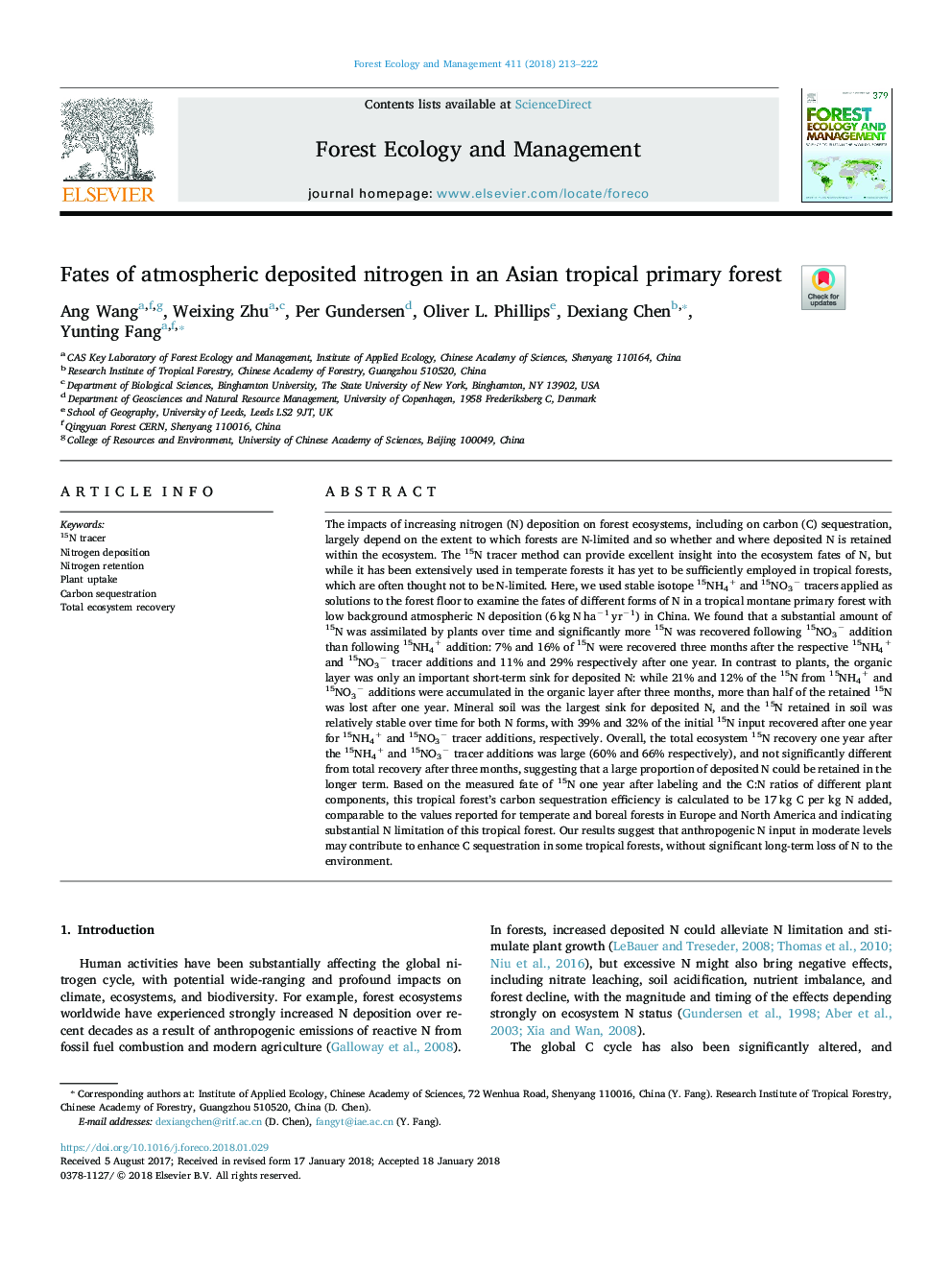| کد مقاله | کد نشریه | سال انتشار | مقاله انگلیسی | نسخه تمام متن |
|---|---|---|---|---|
| 6541835 | 1421347 | 2018 | 10 صفحه PDF | دانلود رایگان |
عنوان انگلیسی مقاله ISI
Fates of atmospheric deposited nitrogen in an Asian tropical primary forest
ترجمه فارسی عنوان
سرنوشت نیتروژن ذخیره شده جو در یک جنگل اولیه آسیایی گرمسیری
دانلود مقاله + سفارش ترجمه
دانلود مقاله ISI انگلیسی
رایگان برای ایرانیان
کلمات کلیدی
15 نکته رسوب نیتروژن، احتباس نیتروژن، جذب گیاه، تداخل کربن، بازیابی اکوسیستم مجموع،
موضوعات مرتبط
علوم زیستی و بیوفناوری
علوم کشاورزی و بیولوژیک
بوم شناسی، تکامل، رفتار و سامانه شناسی
چکیده انگلیسی
The impacts of increasing nitrogen (N) deposition on forest ecosystems, including on carbon (C) sequestration, largely depend on the extent to which forests are N-limited and so whether and where deposited N is retained within the ecosystem. The 15N tracer method can provide excellent insight into the ecosystem fates of N, but while it has been extensively used in temperate forests it has yet to be sufficiently employed in tropical forests, which are often thought not to be N-limited. Here, we used stable isotope 15NH4+ and 15NO3â tracers applied as solutions to the forest floor to examine the fates of different forms of N in a tropical montane primary forest with low background atmospheric N deposition (6â¯kgâ¯Nâ¯haâ1â¯yrâ1) in China. We found that a substantial amount of 15N was assimilated by plants over time and significantly more 15N was recovered following 15NO3â addition than following 15NH4+ addition: 7% and 16% of 15N were recovered three months after the respective 15NH4+ and 15NO3â tracer additions and 11% and 29% respectively after one year. In contrast to plants, the organic layer was only an important short-term sink for deposited N: while 21% and 12% of the 15N from 15NH4+ and 15NO3â additions were accumulated in the organic layer after three months, more than half of the retained 15N was lost after one year. Mineral soil was the largest sink for deposited N, and the 15N retained in soil was relatively stable over time for both N forms, with 39% and 32% of the initial 15N input recovered after one year for 15NH4+ and 15NO3â tracer additions, respectively. Overall, the total ecosystem 15N recovery one year after the 15NH4+ and 15NO3â tracer additions was large (60% and 66% respectively), and not significantly different from total recovery after three months, suggesting that a large proportion of deposited N could be retained in the longer term. Based on the measured fate of 15N one year after labeling and the C:N ratios of different plant components, this tropical forest's carbon sequestration efficiency is calculated to be 17â¯kg C per kg N added, comparable to the values reported for temperate and boreal forests in Europe and North America and indicating substantial N limitation of this tropical forest. Our results suggest that anthropogenic N input in moderate levels may contribute to enhance C sequestration in some tropical forests, without significant long-term loss of N to the environment.
ناشر
Database: Elsevier - ScienceDirect (ساینس دایرکت)
Journal: Forest Ecology and Management - Volume 411, 1 March 2018, Pages 213-222
Journal: Forest Ecology and Management - Volume 411, 1 March 2018, Pages 213-222
نویسندگان
Ang Wang, Weixing Zhu, Per Gundersen, Oliver L. Phillips, Dexiang Chen, Yunting Fang,
